
History of Black Women in the Military
Introduction
African American women have played a role in every war effort in United States history. They endured physical discomfort and personal criticism, while many of their contributions were unrecognized and unrewarded. They placed themselves in danger’s path – offering their abilities and strengths to preserve values and ensure freedom. Women stood side by side with fathers, husbands, and sons to nurse and comfort the suffering; they engaged in the danger of spying, chronicled the pain of war, and offered spiritual healing (Sheafer, 1996). In addition, black women faced racial and gender discrimination as part of their military service. Nevertheless, there were a number of “breakthrough” moments as they persistently pursued their right to serve.
These pioneering women simultaneously mastered the art of building and sustaining family and community life while dealing with wars. They were practiced folk healers, skilled seamstresses, quilters, knowledgeable parents, gardeners, cooks, and kept a storehouse of history and communal information. They knew how to press their skills into service for others. Throughout history, their networking and institution-building skills and their commitment to caring and sharing found expression in educational and health care efforts, campaigns to support the troops, and protests against many forms of discrimination (Lemke-Santangelo, 2003).
Black women have always been active participants in the military. They were always there!
Revolutionary War (1775-1783) and the War of 1812
African-American women played major support roles during the Colonial period by providing help to the militia.
Their assistance included roles such as moving into the “big house” to support the slaveowner’s wife when he went away to serve in the militia, taking care of wounds, and working alongside the men in building forts for safety from both the Indians and the British. African-American females also played a major role as spies during the Revolutionary War.
They kept Colonial authorities informed on the British. With the promise of freedom from slavery as a motivating factor, the African-American woman found innovative ways to assist. According to Lucy Terry’s written accounts of the war, Black women disguised themselves as men and fought side by side with them against the British, and kept the homes so that White women could go near their husbands during engagements.
Phillis Wheatley, a very literate Black woman, used her writing ability to praise and express appreciation for General George Washington during the Revolutionary War. He showed his appreciation by inviting her to visit him at his headquarters in February of 1776.

Phillis Wheatley
Civil War (1861-1865)
During the Civil War, black women’s service included nursing, domestic chores in medical settings, laundering and cooking for the soldiers. The Union Army paid black women to raise cotton on plantations for the northern government to sell.
Five black nurses served aboard the U.S. Navy hospital ship - Red Rover. Four names were recorded – Alice Kennedy, Sarah Kinno, Ellen Campbell, and Betsy Young. They also served in both Union and Confederate hospitals. As many as 181 black nurses (male and female) served in convalescent and U.S. government hospitals in Maryland, Virginia, and North Carolina (womensmemorial, 2010).
Women like Harriet Tubman were an inspiration during the Civil War. She served as a Union spy, an unpaid soldier, a volunteer nurse, and a freedom fighter. She earned the name "General" Tubman from the soldiers in the field. After the Civil War, Tubman formed the Boston Branch of the Women's Relief Corps. Her memoirs, published in 1902, became the only written record of black volunteer nurses in the Civil War (Hodges, 1995).
Born on the Grest Farm in Liberty County, Georgia, on August 6, 1848, Susie Baker King Taylor was raised as an enslaved person. Her mother was a domestic servant for the Grest family. At the age of 7, Baker and her brother were sent to live with their grandmother in Savannah. Even with the strict laws against formal education of African Americans, they both attended two secret schools taught by black women. Baker soon became a skilled reader and writer.
By 1860, having been taught everything these two black educators could offer, Baker befriended two white individuals, a girl and boy, who also offered to teach her lessons even though they knew it violated Georgia law and custom.

Harriet Tubman

Susie Baker King Taylor
The first colored troops did not receive any pay for 18 months and the men had to depend wholly on what they received from the commissary...their wives were obliged to support themselves and children by washing for the officers and making cakes and pies which they sold to the boys in the camp. Finally in 1863, the government decided to give them half pay, but the men would accept none of this. They preferred rather to give their services to the state, which they did until 1864, when the government granted them full pay, with all back due pay.
The Civil War brought Baker her freedom but not immediately. On April 1, 1862, at age 14, Baker was sent back to the country to live with her mother around the time Federal forces attacked nearby Fort Pulaski. When the fort was captured by the Union Army, Baker fled with her uncle’s family and other African Americans to Union-occupied St. Simons Island where she claimed her freedom. Since most African Americans did not have an extensive education, word of Baker’s knowledge and intelligence spread among the Army officers on the island.
Five days after her arrival, Baker was offered books and school supplies by Commodore Louis M. Goldsborough if she agreed to organize a school for the children on St. Simon’s Island. Baker accepted the offer and became the first black teacher to openly instruct African American students in Georgia. By day she taught children and at night she instructed adults. Baker met and married her first husband, Edward King, a black non-commissioned officer in the Union Army, while teaching at St. Simon Island.
For the next three years, Susie Baker King traveled with her husband’s regiment, working as a laundress while teaching black Union soldiers how to read and write during their off-duty hours. She also served as a nurse, helping camp doctors care for injured soldiers.
In 1866, the Kings returned to Savannah, where she established a school for freed black children. In that same year, Edward King died in September only a few months after their first son was born.
By the early 1870s, she moved to Boston, Massachusetts where she met her second husband, Russell Taylor. With nursing being a passion of hers, Baker soon joined and then became president of the Women’s Relief Corps, which gave assistance to soldiers and hospitals.
In 1890, after a trip to care for her dying son, Baker wrote her memoirs which she privately published them as a book in 1902 as Reminiscences of My Life in Camp with the 33rd US Colored Troops. Susie Baker King Taylor died in 1912 at the age of sixty-four in Boston.
On November 15, 1866, Cathay Williams enlisted in the U.S. Regular Army in St. Louis, Missouri. She stood at 5’9” and when asked her name, she replied William Cathay. She was assigned to Company A of the 38th Infantry (a Buffalo Soldiers unit) and was stationed at Jefferson Barracks, Missouri. By April 1867, William Cathay’s company had marched to Fort Riley, Kansas but she was hospitalized several times and did not return to duty until May. In June, her company moved to Fort Harker, Kansas. On July 20, 1867, Company A arrived at Fort Union, New Mexico – a march of 536 miles. On September 7, they marched to Fort Cummings, New Mexico and were stationed there for eight months. William Cathay apparently withstood the marches as well as any man. She did garrison duty, drilled, and trained and went on scouts for signs of Indians.

Cathay Williams
In January 1868, her health began to deteriorate and she was admitted to the hospital at Fort Cummings. She returned to duty after three days but was re-admitted to the hospital in March but, again, returned to duty after three days. On June 6, her company marched 47 miles to Fort Bayard, New Mexico (Buffalo Soldiers, 2010). Fort Bayard was located at the base of the Santa Rita Mountains – hostile Apache territory. The fort had suffered a number of raids through the summer. In addition, the soldiers of the U.S. 38th mounted for escort duty and occasionally drove government horses and herds of cattle to other posts. Fort Bayard was dangerous duty for Private William Cathay. One of the officers wrote:
The Indians would come down through the pine forests close to Fort Bayard and fire into the post. Sentinels at the haystacks were often found killed with arrows. It was unsafe to leave the post without an escort (Tucker, 2002).
William Cathay was admitted to the hospital on July 13 and diagnosed with neuralgia. She did not report back to duty for one month. On October 14, 1868, she and two other privates in Company A, 38th Infantry were discharged at Fort Bayard on a surgeon’s certificate of disability. William Cathay’s certificate stated that (s)he had been feeble both physically and mentally and unfit for duty. The note claimed that (s)he was continually on sick report without benefit and unable to do military duty. The condition dates prior to enlistment. This certificate of disability ended William Cathay’s brief military career. She resumed her identity as a woman and travelled to Fort Union to work as a cook. She later moved to Pueblo, Colorado and worked as a laundress before settling in Trinidad, Colorado (buffalosoldier, 2010).
Cathy Williams was not the only woman to join the U.S. Army before 1948 – the year that women were allowed for the first time to officially enlist in the peacetime Army. Approximately 400 women posed as soldiers during the Civil War. Many of these women enlisted with their husbands, brothers, and fiancés and most were not found out unless they required hospital treatment (Cathay Williams, 2010)
Spanish American War (1898)
Black American females again played the role of nurses. During this war, over 75 percent of all deaths resulted from typhoid and yellow fever. Many Black female volunteer nurses were told that they were immune to the diseases because their skin was darker and thicker. Because of this, many of them exposed themselves to the diseases and became casualties when they returned home. Because of segregated living areas, the Whites never knew the high rate of casualties that these women suffered. The Army was so pleased with the 32 contract Black nurses, however, that many congressmen tried but failed to create a permanent corps of Army nurses.
World War I (1914-1918)
For the first time in military history, African-American females had an official organization where they found leadership and direction to use their abilities. The National Association of Colored Graduate Nurses was founded in 1909. In 1917, the co-founder of the Red Cross urged black nurses to enroll in the American Red Cross, although they were not accepted until two months before the war ended in November 1918. African-American females continued to serve by making bandages, taking over jobs that men held so they could be soldiers, working in hospitals and troop centers, and serving in other relief organizations as they had in previous wars. Many served in Hostess Houses operated by the Young Women's Christian Association, where they wrote letters home for illiterate soldiers and read incoming mail to them (Hodges, 1995).

Black soldiers on troop train passing through New Orleans being served chocolates and cigarettes by the Colored Auxiliary of the American Red Cross (Scott, 1919)
As the war escalated, public pressure increased to enlist black women. Eighteen black Red Cross nurses were offered Army Nurse Corps assignments at Camp Grant, Illinois and Camp Sherman, Ohio. They cared for German prisoners of war and black soldiers. By August 1919, all black nurses were released from service.
One of the nurses, Aileen Cole Stewart, wrote:
The story of the Negro nurse in World War I is not spectacular. We arrived after Armistice was signed which alone was anticlimactic. So we had no opportunity for “service above and beyond the call of duty.” But each one of us…did contribute quietly and with dignity to the idea that justice demands professional equity for all qualified nurses.
After World War I, the demand for a permanent place for black women nurses in the military nursing corps continued. Colonel C.R. Darnell, Executive Officer for the Army Medical Corps wrote:
The question of opening the nurse corps to…colored nurses has from time to time received the serious consideration of this office; but because of the necessity… of arranging their tours of duty in various regions of the United States as well as in our overseas dependencies [.] and of the difficulty if not impossibility of arranging proper quarters and messing facilities for them [.] their employment has been found impractical in times of peace. You may rest assured that when military considerations make it practicable…to utilize colored nurses they will not be overlooked.
Black women served in other capacities, as well. Four black women were among the 3,480 “Y” women volunteers who helped soldiers and sailors overseas. The YMCA provided recreation for the American Expeditionary Forces by staffing canteens, nursing, sewing, baking, and providing amusement and educational activities for the soldiers (womensmemorial, 2010).

Group of Red Cross Nurses on duty as the base hospital at Camp Grant, Illinois. (Scott, 1919).
World War II (1939-1945)
In January 1941, the Army opened its nurse corps to blacks but established a ceiling of 56 women. In June 1943, Frances Payne Bolton, Congresswoman from Ohio introduced an amendment to the Nurse Training Bill to bar racial bias. Soon 2,000 black women were enrolled in the Cadet Nurse Corps. By July 1944, the quota for black nurses was eliminated. More than 500 black Army nurses served stateside and overseas during the war.
The Honorable Edith Nourse Rogers, Congresswoman from Massachusetts introduced the first bill to establish a women’s auxiliary in May 1941. Congress approved the creation of the Women’s Army Auxiliary Corp (WAAC) on May 14, 1942. Five training centers were opened within a year; they were located at Fort Des Moines, Iowa; Daytona Beach, Florida; Fort Oglethorpe, Georgia; Fort Devens, Massachusetts; and Camp Ruston, Louisiana. As an auxiliary of the Army, the WAAC had no military status (armywomen, 2010).
From its beginning in 1942, black women enlisted in the WAAC (Women’s Auxiliary Army Corps) – the first group arrived at Fort Des Moines, Iowa where there were 400 white women and 40 black women. Enlisted women served in segregated units, participated in segregated training, lived in separate quarters, ate at separate tables, and used separate recreational facilities (womensmemorial, 2010).
Fort Huachuca in the Arizona desert had the largest concentration of black soldiers after the Army created the U.S. 93rd Infantry Division. By December 1942, the 32nd and 33rd Companies of the WAAC joined the men of the 93rd. These women were postal clerks, stenographers, switchboard operators, motor truck drivers, and typists fulfilling jobs that released the men for combat (Moore and Taylor, 2003).
A bill was introduced in 1943 to enlist and appoint women in the U.S. Army. President Franklin D. Roosevelt signed the bill on July 1, 1943 which discontinued the WAAC and in its place the Women’s Army Corp was formed (armywomen, 2010).
The Army had the Women's Army Corps (WAC); the Navy had the Women Accepted for Volunteer Emergency Service (WAVES); and the Coast Guard had the SPARS. The majority of African-American women served in the WAC. They remained in segregated units, as did the African-American men. Although the Navy intended to increase the number of African-Americans to 10%, there were still less than 50 black WAVES by 1945 (Hodges, 1995). The efforts of Director Mildred McAfee and Mary McLeod Bethune helped Secretary of the Navy Forrestal push through their admittance. Two black WAVES officers, Harriet Ida Pickens and Frances Wills, were sworn in on December 22, 1944. Of the 80,000 WAVES, a total of 72 black women served under integrated conditions (womensmemorial, 2010).
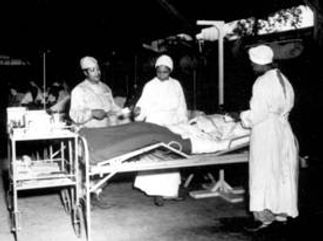
Surgical ward treatment at the 268th Station Hospital, Base A, Milne Bay, New Guinea. Left to right: Sgt. Lawrence McKreever, patient; 2nd Lt. Prudence Burns, ward nurse; 2nd Lt. Elcena Townscent, chief surgical nurse; and an unidentified nurse." June 22, 1944. Pfc. Michael Pitcairn. 111-SC-28748.
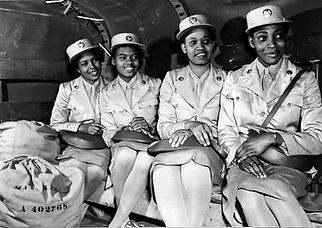
WAACs, Privates Florence B. Davis, Dorothy L. Harris, Mildred L. Turk and Juanita P. Ingraham leaving Fort Des Moines going to Fort Clark. Prints and Photographs Division, Library of Congress 1943-45.
The U.S. Coast Guard had even less in the SPARS. Out of the highest number of women in the military during this period (271,000), only 4,000 were African-American women. There simply weren't many opportunities for them (Hodges, 1995).
In early 1945, 855 African American women who were members of the WAC were sent to England to sort through millions of undelivered pieces of mail destined for American troops. The all-black 6888th Central Postal Directory Battalion worked in Birmingham, England and later in Rouen, France handling the backlog of mail piled from the floor to the ceiling in warehouses and airplane hangars. Led by Major Charity Earley Adams, the first African American woman officer in the Women’s Army Corps, the 6888th worked around the clock in three shifts to sort through the backlog of mail. Mail was an important morale booster for the soldiers but their job was not easy. The women had to deal with dim lights, cold weather, and poor heating as the shipments continued to be delivered. Many envelopes and packages were addressed to “Junior” or “Buster” so they had to research the letters for clues to get each package to the right person. Often the soldiers had moved on to another location once the mail had the proper identification. In May 1945, they completed their task in Birmingham and moved to Rouen to clear another backlog. They were given a six month deadline but finished the project in half that time.
After their work was completed, they were discharged without any special recognition for what they had accomplished (ww2 blackwomen, 2009).
After victory in Europe in May 1945 and the surrender of the Japanese in August, the training centers at Fort Oglethorpe and Fort Des Moines closed. The War Department began a program aimed at retaining women in the service and re-enlisting those who had served. The Chief of Staff, Dwight D. Eisenhower, announced that he would ask Congress to make the WAC a part of the Regular Army and the Organized Reserve Corps. By the end of May 1946, WAC numbers decreased from 99,000 to about 21,500. By May 1948, the numbers totaled approximately 6,500 women (armywomen, 2010).
On June 12, 1948, President Harry S. Truman signed into law the Women’s Armed Services Integration Act that permitted women in the Regular Army and the Organized Reserve Corps. A new training center at Camp Lee, Virginia opened in July 1948 (armywomen, 2010). Although the bill established a permanent place for women in the Army, Navy, Air Force, and Marine Corps, it set a 2% ceiling on the number of women in each service (Bellafaire, 2010).
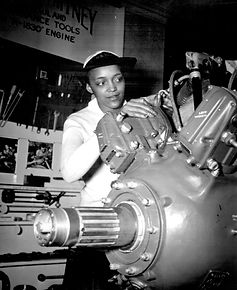
Inspecting a Grumman Wildcat engine on display at the U.S. Naval Training School (WR) Bronx, NY, where she is a 'boot' is WAVE Apprentice Seaman Frances Bates. 1945. 80-G-18337
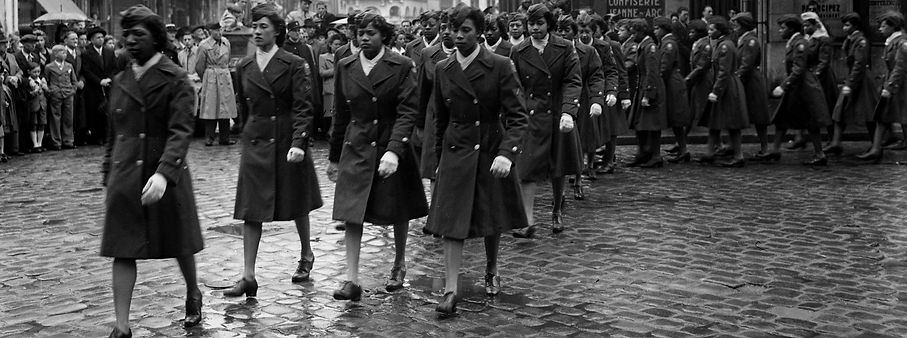
Members of the 6888th Central Postal Directory Battalion take part in a parade ceremony in honor of Joan d'Arc at the marketplace where she was burned at the stake. May 27, 1945.Pfc. Stedman. 111-SC-42644
Korean War (1950-1953)
African-American women continued to serve in the Korean Conflict. As political and military leaders considered instituting a peacetime draft, it occurred to some that if volunteer servicewomen, who had filled manpower needs during World War II, could be used to fill the military’s increasing need for office workers, fewer men would have to be drafted. Cost comparisons revealed that training men was more expensive than training women. The main reason for the cost difference was that young men frequently had dependents who required housing, medical care, and other allowance. Women, on the other hand, were not accepted into the military if they had under-age dependents.
The Korean War was the first armed conflict since the American Revolution that saw black and white Americans fighting in the same units. President Truman issued Executive Order 9981, mandating an end to racial discrimination and segregation in the armed forces. Six years later after studying the effects of integration, the Department of Defense announced that segregation had been eliminated in all of the armed forces (Bellafaire, 2010).
In August 1950, many WAC officers and enlisted reservists returned voluntarily to active duty. WAC detachments were established in Japan to support the men fighting in Korea. A WAC unit was not sent to Korea but in 1952, a few women filled administrative positions there (armywomen, 2010). Black members of WAC also served at military bases in Okinawa, Japan, and the Philippines. Corporal Arline Haywood Wall was assigned to the Yokohama Engineering Depot; she helped get supplies to soldiers. Estella Ehelebe of the U.S. Army Special Services wrote letters of condolence to families of soldiers who died in Korea.
Almost 600 military nurses served in hospitals established in the Korean Theater. African American nurses included Lieutenant Martha E. Cleveland (later Colonel) and Lieutenant Nancy Greene Pease both of whom were assigned to the 11th Evacuation Hospital and Lieutenant Evelyn Decker of the 8055 MASH unit. Other black nurses were assigned to hospitals in Japan, Hawaii, and the west coast of the United States (Bellafaire, 2010).
In 1952, Army Nurse Captain Eleanor Yorke was the only female passenger among 4,200 men sailing on military transport from the Far East to San Francisco. Captain Yorke had spent more than two years in Japan and eight more months in Korea treating war wounded. On the 13-day trip home, her fellow passengers treated Captain Yorke like a queen.
Besides being the only woman aboard military transport, Captain Yorke was one of only about 600 women—only a few of whom were African American—stationed in Korea during the entire three years of the Korean War.
The American cultural climate of the time relegated most women to non-professional, low-paying jobs and promoted a feminine ideal of domesticity and maternalism. The armed forces reflected this attitude, offering women “pink collar” jobs with little room for advancement.
As the Korean War began, the effects of decades of protest, and political and legal activism had made few inroads into racial segregation. The inequities of the “separate-but-equal” doctrine of the 1896 Plessy v. Ferguson Supreme Court decision still shaped public policy, race relations and white attitudes in most of America.
African American women who volunteered in the military during this period stepped over dual barriers of gender and race to serve their country and test new policies.
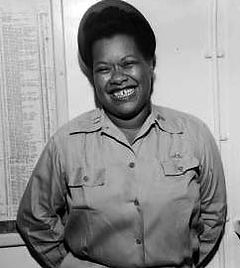
Army Nurse Captain Eleanor Yorke
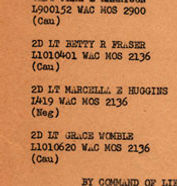
Racial identification was standard on military documents.
Viet Nam (1959-1975)
During the Viet Nam War, increasing number of women – including African Americans – volunteered for duty. In 1965, Major Monica Crossdale-Palmer served at the 85th Evacuation Hospital at Quin How and later at the 17th Field Hospital in Saigon. In March 1967, she returned to the United States and served in the operating room at Walter Reed Hospital in Washington, DC. She volunteered to return to Viet Nam and served as operating room supervisor of the 45th Surgical Hospital at Tay Rinh, near the Cambodian border.
Other women who worked tirelessly included Major Marie L. Rogers, Army Nurse Corps, an 18 year veteran, who served in Korea and Viet Nam; she received the Bronze Star from President Lyndon B. Johnson for distinguished service regarding group operations against a hostile force in Viet Nam. Captain Elizabeth Allen, Army Nurse Corps, treated acute battle injuries in intensive care units in Army hospitals at Pleiku and Ku Chi. The hospital was fired on every night during the Tet Offensive so she and other medical personnel lowered the patients’ beds onto empty ammunition boxes. In 1968, Olivia Theriot, U.S. Air Force Nurse was stationed in the Philippines with the 902nd Aeromed Evacuation Squad. She flew in and out of Saigon, moving the wounded between Viet Nam, the Philippines, and Japan. Army Nurse Diane M. Lindsay was assigned to the 95th Evacuation Hospital where she convinced a confused soldier to hand over a grenade. She was the first black nurse to receive the Soldier’s Medal of Heroism for her actions and was later promoted to captain.
Black members of the WAC also served in Viet Nam. WACs on duty at Long Binh, 27 miles from Saigon, were stationed in an area that was frequently attacked during the Tet Offensive. Staff Sergeant Edith Efferson helped the other women remain calm. Chief Warrant Officer Doris Allen recalled:
As a senior intelligence analyst… I was recognized for having been responsible through production of one specific intelligence report, for saving the lives of at least 101 U.S. Marines fighting in Quang Tri Province… During my years of service I survived many prejudices against me as a woman, as a WAC, me as a soldier with the rank of specialist, me as an intelligence technician, and me as a Black woman; but all of the prejudices were overshadowed by a wonderful camaraderie.
Specialist Grendel Alice Howard was assigned to the First Logistical Command Headquarters at Long Binh as an administrative assistant to the Non-Commissioned Officer in charge. She interviewed soldiers and wrote stories about them for publication. After a 34-month tour, she was promoted to Sergeant First Class and later to Sergeant Major. She earned the Bronze Star with the Oak Leaf Cluster and the Army Commendation Medal with Oak Leak Cluster.
When the Viet Nam War ended, the draft also ended. For a volunteer army to work, women of all races were needed. Women were able to join the National Guard and were admitted to ROTC programs. In 1976, women were allowed to enroll at the service academies.
On September 1, 1979, Hazel W. Johnson became the first black woman general office when she assumed the position of chief of the Army Nurse Corps. Later, on June 22, 1995 at the groundbreaking ceremony for the Women in Military Service for America Memorial, Brigadier General Hazel W. Johnson-Brown US Army Nurse Corps (retired) said:
In the past, women, particularly minority women, have always responded when there was a crisis or need. We acknowledge all minority women in uniform, both present… and not present. You are the strength of our success. You represent the patchwork quilt of diversity which is America – race, creed, color, and ethnicity (womensmemorial, 2010).
The Persian Gulf War (1990-1991)
The conflict in the Persian Gulf began in 1990 after talks between Iraq and Kuwait did not resolve issues over the price of oil. Iraq’s president, Saddam Hussein, sent armies to invade Kuwait. On August 7, when Hussein refused to remove his troops, President George Bush ordered Operation Desert Shield. Then, on January 16, 1991, Operation Desert Storm began. Military targets such as command and communication centers, missile launch sites, radar facilities, airports, runways and Iraqi ground forces were under heavy attack. More than 40,000 women were deployed and several thousand served in from the mainland (militarywomenveterans, 2010).

African-American women served with distinction during Operation Desert Storm as officers, noncommissioned officers, and enlisted soldiers. Of the 35,000 females who went to Desert Storm, an estimated 40% of them were African-Americans. According to Staff Sergeant Betty Brown of the Washington, DC Army National Guard, all of these women endured the heat and primitive conditions which included no electricity, no running water, no bathrooms, and sanitation details (cleaning the 10 gallon trash cans that served as toilets).
Lieutenant Phoebe Jeter, who headed an all-male platoon, ordered 13 Patriot missiles fired and destroyed at least two Scuds (Iraqi surface-to-surface missiles). She was the first and only woman to shoot down a Scud missile. (Randolph, 1991). Captain Cynthia Mosely, commanded Alpha Company, 24th Support Battalion Forward, 24th Infantry Division (Mechanized), a 100-person unit that supplied everything from fuel to water to ammunition. Her unit resupplied fuel for all of the forward brigades because it was closest to the front lines. Her memories from her jeep on Highway 8 include this recollection:
All of the bodies I saw—that will stay with me the rest of my life. I’ve never witnessed such a large amount of dead bodies…just scattered everywhere. We came up just six hours after the fighting so we were relatively close behind the maneuver. There were civilians, but most of [the bodies] were Iraqi soldiers. We saw children and some infants as well that were dismembered, a lot of their body parts… I don’t think it’s anything you ever forget. You just learn to live with it and continue on.

Many black women left their jobs, families, husbands, and children when their country called them to war. Major Marilyn Bridgette and Staff Sergeant Betty Brown, Army National Guard members, were called to the Gulf on Christmas Eve. They were told, “You’ve got 72 hours,” recalled Sergeant Brown. Each person had to make a will and execute a power-of-attorney. Preparing their families was by far the most difficult task. Army Major Carrie Kendrick said that her biggest challenge was alleviating the concerns her husband has about her safety. Her husband was also in the Army but was not called to duty in the Gulf (Randolph, 1991).
The manner in which each soldier is treated remains an important concern. Shoshana Johnson, African American, and Jessica Lynch, white, who were held hostage in Iraq, returned home with serious injuries. Johnson received a 30% disability benefit for her injuries while Lynch received an 80% disability benefit and substantial media coverage (Westside Gazette, 2003).
The death and injury toll for women in Iraq and Afghanistan continues to climb. According to U.S. military records, 33 women have been killed since 2001. In addition, 240 women have sustained combat-related wounds and are left with permanent disabilities that sometimes require amputation (Ginty, 2010).

Shoshana Nyree Johnson
War in Iraq and Afghanistan (2003- current)
Women – black and white - account for 15% of all military service and 10% serve as soldiers in Iraq and Afghanistan. Compared to the Gulf War, the number of enlisted women soldiers has decreased from 216,000 to 17,000 women in Iraq and Afghanistan. At the beginning of the Gulf War, women are barred from jobs that involved direct combat (on submarines, with the Special Forces, and infantry, armor, and artillery positions). They are also barred from “collocated units” that support combat troops. A woman could serve as a medic but not in a unit that “collocated” or supported a unit on the front line.
In 1994, the Army dropped a rule prohibiting women from filing positions with a “substantial risk of capture.” These changes opened up 90% of military jobs to women for the first time. Today, women take infantry training alongside men. They work as engineers, truck drivers, pilots, and weapon experts.
According to a tribute to black women and women of color fallen soldiers (2006), 34 fallen soldiers are pictured ranging in age from 18-47. A number of these women died from non-combat related injuries and remain under investigation. These women served in every branch of the military and at all ranks. They served in Mosul, Baghdad, Fallujah, and many other areas in Iraq and Afghanistan. In January, 2002 the first black female soldier listed was Marine Corps Sergeant Jeannette L. Winters, 25, from Gary, Indiana who was killed during a refueling tanker crash in Pakistan. Eighteen states are represented including Maryland, North and South Carolina, Virginia, Texas, Louisiana, California, Missouri, and Alaska as well as Puerto Rico (Tribute, 2006).
Black women are well represented in the armed forces today. An estimated 40% of the 35,000 women active in Operation Desert Storm were African-Americans. Their gallantry was best exemplified by Lt. Phoebe Jeter, who ordered her all-male platoon to fire a battery of Patriot missiles at incoming Iraqi Scud missiles, downing at least two of them. It was the first and only such feat by a female officer in the war.
U.S. Navy Vice Adm. Michele Howard, the first African-American woman to command a Navy combat ship, made news in 2009 when it was involved in the rescue of the merchant ship Maersk Alabama’s captain from Somali pirates.
“It is clear to all of us that women are contributing in unprecedented ways to the military’s mission of defending the nation,” said Defense Secretary Leon Panetta in January, when he lifted a ban preventing women from serving in combat. “They serve, they’re wounded and they die right next to each other. The time has come to recognize that reality.”
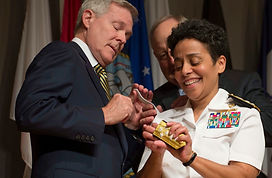
U.S. Navy Vice Adm. Michele Howard
Emily Jazmin Tatum Perez (19 February 1983 – 12 September 2006) was a Cadet Command Sergeant Major in the United States Military Academy at West Point.
Born in Heidelberg, West Germany, of African American and Hispanic parents in a U.S. military family, she graduated from Oxon Hill High School in Maryland, where she ranked among the top-10 students in her class. In July 2001, after graduation from high school, Perez entered the United States Military Academy at West Point. There she was an exemplary student and talented track athlete, becoming the highest-ranking African-American female cadet in the history of West Point. Following graduation from West Point in 2005, she was commissioned a Second Lieutenant in the 204th Support Battalion, 2nd Brigade, 4th Infantry Division of the United States Army. Perez was killed in action on September 12, 2006, while leading a convoy through Al Kifl, Iraq, a mission for which she had volunteered. She was the first female African-American officer in US military history to die in combat.

2nd Lt. Emily Perez
As illustrated in the photo, black women continue to serve in a diverse arena of military positions. Sgt. Danyell E. Wilson was the first black woman Tomb Sentinel (The Old Guard) at Arlington National Cemetery (Hodges, 1995).
Conclusion
Black women who served in the military since pre-colonial days have paved the way for new recruits and current active duty females to follow. In 1993, black women comprised 33% of Army female recruits, 22% of Navy female recruits, 17% of Marine Corps female recruits, and 18% of Air Force female recruits. The statistics show that approximately 30% of the military is African-American women; approximately 34% serve as enlisted, and about 13% serve as commissioned and warrant officers (Hodges, 1995). According to a 2005 report, black women see the military as providing greater opportunities and benefits than the civilian labor market. A total of16% of female officers and 34% of enlisted women are black compared with 9% of male officers and 20% of enlisted men. In the Army, close to one-fourth of women officers and nearly one-half of enlisted women are black. In addition, black women are better represented than white women among noncommissioned officers which reflects their longer stay in the service (America’s military population, 2005)

Sgt Danyell E. Wilson
Other Military Firsts
-
March 8, 1945, Phyllis Mae Daily, the first black nurse was sworn into the Navy Nurse Corps in New York City.
-
In July 1974, Reverend Alice Henderson was commissioned as a chaplain, becoming the first female chaplain, black or white.
-
In May 1975, Lieutenant Donna P. Davis became the first black woman doctor in the Naval Medical Corps.
-
In November 1979, Second Lieutenant Marcella A. Hayes is the 55th woman out of 48,000 officers to graduate from the Army Aviation School in Ft Rucker, Alabama. She became the first black woman pilot in the U.S. armed forces.
-
In December 1980, Ensign Brenda Robinson became the first black female aviator in the U.S. Navy assigned to the Fleet Logistics Squadron Forty in Norfolk, Virginia.
-
On May 18, 1983, Angela Dennis of Arkansas became one of the first two black women to graduate from the U.S. Coast Guard Academy in New London, Connecticut (Hodge, 1995).
Source:
Buffalo Soldiers Research Museum
http://www.buffalosoldiersresearchmuseum.org/research/women.htm
